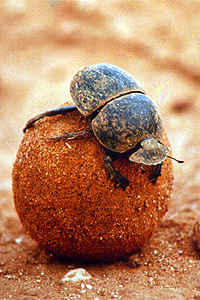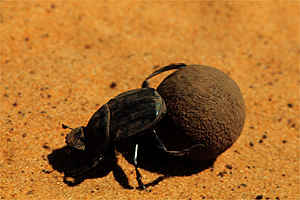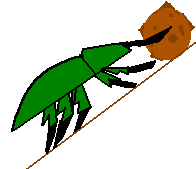|
HOME |
|
|
HOME |
|
Guess what's being served for dinner tonight? If you are a Scarab Beetle, you may feed on plants, grasses, leaves, fruits and flowers. If you are a Dung Beetle you may feast on a rich and leisurely meal of freshly laid fecal matter, otherwise known as dung!
There are many species in the family scarabaeidae, and they are all unique. Some are small like the Ciervo Aegialian, while others are quite huge, like the Goliath. They have different colors and shapes. Some members of the Scarab family are "leaf chafers"; others feed on dung. Can you guess what is on the menu of these beetles?


The Dung Beetles are classified into groups due to their behaviour. They are named Dung Beetles because they eat dung. Sounds gross, doesn't it? Although unusual, their behaviour and eating habits are very helpful for humans and the environment.
With geometric artistry, the Dung Beetles use their legs and mouth parts to form freshly laid dung into huge circular or pear-shaped structures and then roll them into an underground nest that has been prepared by both the male and the female. The female then lays a single egg into each ball of dung and then covers the nest with more dung and soil. When the eggs hatch, the larvae will feed on the fecal matter. Without this natural septic machine, the earth would be piled high with manure.
It is amazing that the Dung Beetles have the ability to roll balls of dung that weight up to fifty times their own weight. Some types of Dung Beetles eat particular types of dung, i.e. the dung of sheep, cow, horse, and camels. Another bizarre characteristic of certain beetles is that they eat other dung beetles and their eggs as well. The life expectancy for most Dung Beetles range from three to five years, with the longest life lines for those kept in captivity.
Due to their distinct behavior, Dung Beetles can be divided into the following three groups: Rollers, Tunnellers, and Dwellers. Rollers succeed more in tropical areas. These beetles roll either sheep or rabbit dung into their burrows. These beetles are most active in winter and hibernate throughout the summer months while living underground. There is a separation of household duties among these beetles. The female does the digging while the male collects the dung. The collected dung is then carefully placed in the underground home by the female. Within the home, there are separate burrows where the female lays single eggs and then covers them with the remaining dung.

Tunnellers form male and female pairs to perform the task of taking the balls of dung into the tunnels. The female sorts through dung and arranges it for placement throughout the tunnel. The male's only part in this housekeeping chore is to keep the female well supplied with fresh dung.
True to their name, the Dwellers live their
lives, as much as possible, inside some sort of dung. They lay
their eggs right into the dung, and the larvae hatch and eat their
way through the lovely food.
Scarab Beetles can be found in South America and Egypt. The Dung Beetle fossils date back 40 million years. The Egyptians immortalized the Scarab Beetle as sacred . The Egyptians believed that the Scarab Beetle represented their sun god, Ra. Ra was the Egyptian god who rolled the sun across the sky and buried it each night. The Scarab Beetle became so sacred that they were put on unique stones to wear as jewelry.
In addition, the scarab beetle appeared in Egyptian heiroglyphs.

The next time you see a beetle,not necessarily a scarab beetle but any type of beetle, think about its movements, its behaviour, and its characteristics. Observe it carefully. You might be surprised what you will find.